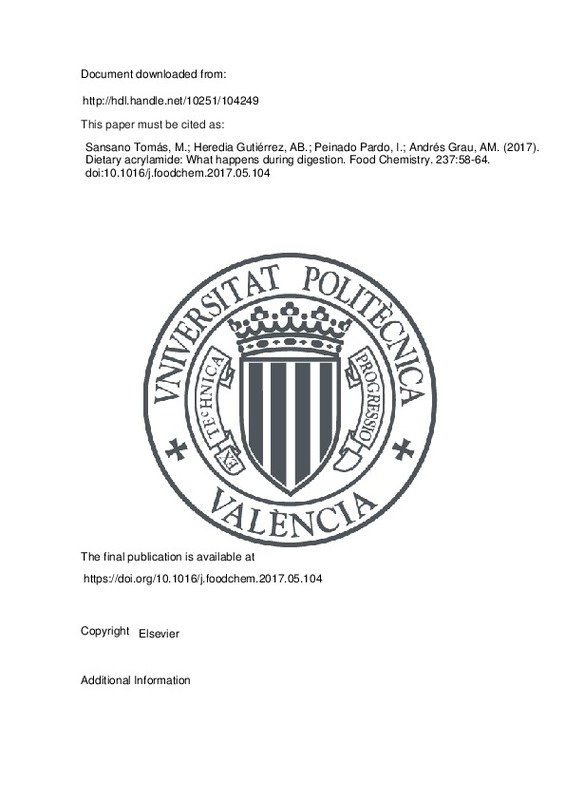JavaScript is disabled for your browser. Some features of this site may not work without it.
Buscar en RiuNet
Listar
Mi cuenta
Estadísticas
Ayuda RiuNet
Admin. UPV
Dietary acrylamide: What happens during digestion
Mostrar el registro sencillo del ítem
Ficheros en el ítem
| dc.contributor.author | Sansano Tomás, Mariola
|
es_ES |
| dc.contributor.author | Heredia Gutiérrez, Ana Belén
|
es_ES |
| dc.contributor.author | Peinado Pardo, Irene
|
es_ES |
| dc.contributor.author | Andrés Grau, Ana María
|
es_ES |
| dc.date.accessioned | 2018-06-18T04:24:02Z | |
| dc.date.available | 2018-06-18T04:24:02Z | |
| dc.date.issued | 2017 | es_ES |
| dc.identifier.issn | 0308-8146 | es_ES |
| dc.identifier.uri | http://hdl.handle.net/10251/104249 | |
| dc.description.abstract | [EN] Acrylamide is a well-known potentially carcinogen compound formed during thermal processing as an intermediate of Maillard reactions. Three objectives were addressed: the impact of gastric digestion on acrylamide content of French Fries, chips, chicken nuggets, onions rings, breakfast cereals, biscuits, crackers, instant coffee and coffee substitute; the acrylamide content evolution during gastrointestinal digestion of French fries and chips; and the effectiveness of blanching and air-frying on acrylamide mitigation after gastrointestinal digestion. A significant increase (p-value < 0.05) in acrylamide content was observed for most of the products after gastric digestion (maximum registered for sweet biscuits, from 30 +/- 8 to 150 +/- 48 mu g/kg). However, at the end of the intestinal stage, acrylamide values were statistically similar (p-value = 0.132) for French fries and lower than the initial values (before digestion) in potato chips (p-value = 0.027). Finally, the low acrylamide content found in blanched and air-fried samples, remained still lower than for deep fried samples even after gastrointestinal digestion. (C) 2017 Elsevier Ltd. All rights reserved. | es_ES |
| dc.description.sponsorship | The authors would like to thank the Universitat Politecnica de Valencia for the PhD scholarship given to Mariola Sansano Tomas. | |
| dc.language | Inglés | es_ES |
| dc.publisher | Elsevier | es_ES |
| dc.relation.ispartof | Food Chemistry | es_ES |
| dc.rights | Reconocimiento - No comercial - Sin obra derivada (by-nc-nd) | es_ES |
| dc.subject | Acrylamide | es_ES |
| dc.subject | In vitro | es_ES |
| dc.subject | Digestion | es_ES |
| dc.subject | Kinetics | es_ES |
| dc.subject | Bioaccessibility | es_ES |
| dc.subject.classification | TECNOLOGIA DE ALIMENTOS | es_ES |
| dc.title | Dietary acrylamide: What happens during digestion | es_ES |
| dc.type | Artículo | es_ES |
| dc.identifier.doi | 10.1016/j.foodchem.2017.05.104 | es_ES |
| dc.rights.accessRights | Abierto | es_ES |
| dc.date.embargoEndDate | 2018-12-15 | es_ES |
| dc.contributor.affiliation | Universitat Politècnica de València. Departamento de Tecnología de Alimentos - Departament de Tecnologia d'Aliments | es_ES |
| dc.contributor.affiliation | Universitat Politècnica de València. Instituto Universitario de Ingeniería de Alimentos para el Desarrollo - Institut Universitari d'Enginyeria d'Aliments per al Desenvolupament | es_ES |
| dc.description.bibliographicCitation | Sansano Tomás, M.; Heredia Gutiérrez, AB.; Peinado Pardo, I.; Andrés Grau, AM. (2017). Dietary acrylamide: What happens during digestion. Food Chemistry. 237:58-64. doi:10.1016/j.foodchem.2017.05.104 | es_ES |
| dc.description.accrualMethod | S | es_ES |
| dc.relation.publisherversion | https://doi.org/10.1016/j.foodchem.2017.05.104 | es_ES |
| dc.description.upvformatpinicio | 58 | es_ES |
| dc.description.upvformatpfin | 64 | es_ES |
| dc.type.version | info:eu-repo/semantics/publishedVersion | es_ES |
| dc.description.volume | 237 | es_ES |
| dc.identifier.pmid | 28764038 | |
| dc.relation.pasarela | S\337798 | es_ES |
| dc.contributor.funder | Universitat Politècnica de València |







![[Cerrado]](/themes/UPV/images/candado.png)

